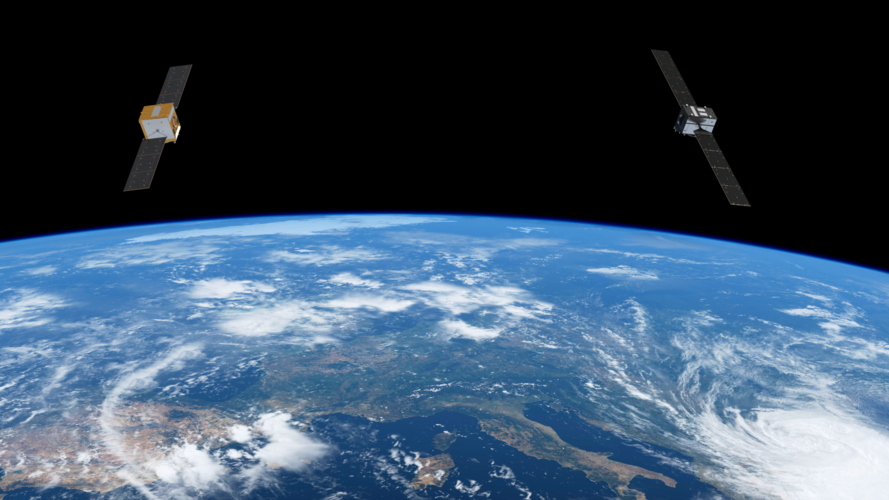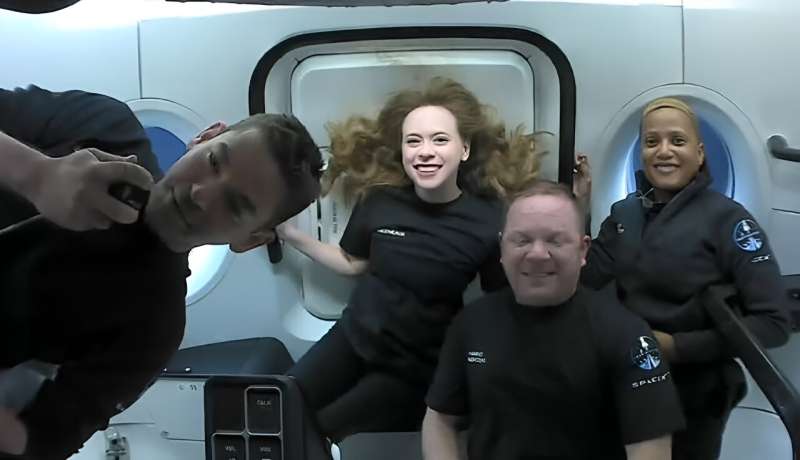NASA satellite detects smaller object in black hole pair for the first time
Wednesday, 12 June 2024 06:50 Several international research groups have confirmed that two black holes exist at the center of the distant galaxy OJ 287, a theory first suggested by astronomers at the University of Turku, Finland. A new study shows that satellite observations conducted in 2021 revealed the smaller black hole of the pair for the first time.
In 2021, NASA's exoplanet-hunting satellite was pointed towards
Several international research groups have confirmed that two black holes exist at the center of the distant galaxy OJ 287, a theory first suggested by astronomers at the University of Turku, Finland. A new study shows that satellite observations conducted in 2021 revealed the smaller black hole of the pair for the first time.
In 2021, NASA's exoplanet-hunting satellite was pointed towards NASA Swift Satellite and AI Improve Measurement of Gamma-Ray Bursts
Wednesday, 12 June 2024 06:50 Astronomers are utilizing AI to measure the expansion of the universe. Two studies led by Maria Dainotti, a visiting professor with UNLV's Nevada Center for Astrophysics and assistant professor at the National Astronomical Observatory of Japan (NAOJ), applied machine learning models to enhance distance measurements for gamma-ray bursts (GRBs). GRBs are the most luminous explosions in the univers
Astronomers are utilizing AI to measure the expansion of the universe. Two studies led by Maria Dainotti, a visiting professor with UNLV's Nevada Center for Astrophysics and assistant professor at the National Astronomical Observatory of Japan (NAOJ), applied machine learning models to enhance distance measurements for gamma-ray bursts (GRBs). GRBs are the most luminous explosions in the univers Hainan Launch Center Completes Construction for First Mission
Wednesday, 12 June 2024 06:50 Construction of the Hainan International Commercial Aerospace Launch Center has been completed in Wenchang, Hainan province, after nearly two years of work, the center announced in a news release.
The center's second launch service tower was finished on Thursday, and engineers have started preparing it for its maiden launch mission - the debut flight of the Long March 12 carrier rocket.
Construction of the Hainan International Commercial Aerospace Launch Center has been completed in Wenchang, Hainan province, after nearly two years of work, the center announced in a news release.
The center's second launch service tower was finished on Thursday, and engineers have started preparing it for its maiden launch mission - the debut flight of the Long March 12 carrier rocket. NASA's Repository Advances Research on Commercial Astronaut Health
Wednesday, 12 June 2024 06:50 NASA's Open Science Data Repository provides valuable information to researchers studying the impact of space on the human body. Nearly three years after the Inspiration4 commercial crew launch, biological data from the mission represents the first comprehensive, open-access database to include commercial astronaut health information.
Access to astronaut research data from astronauts has h
NASA's Open Science Data Repository provides valuable information to researchers studying the impact of space on the human body. Nearly three years after the Inspiration4 commercial crew launch, biological data from the mission represents the first comprehensive, open-access database to include commercial astronaut health information.
Access to astronaut research data from astronauts has h Slingshot Aerospace and DARPA Create AI to Detect Anomalous Satellites
Wednesday, 12 June 2024 06:50 Slingshot Aerospace, Inc. has collaborated with the Defense Advanced Research Projects Agency (DARPA) to develop Agatha, an AI system designed to identify anomalous spacecraft in large satellite constellations.
With over 10,000 satellites planned for deployment by various international entities, verifying the operation of these satellites is critical.
"Agatha represents a breakthroug
Slingshot Aerospace, Inc. has collaborated with the Defense Advanced Research Projects Agency (DARPA) to develop Agatha, an AI system designed to identify anomalous spacecraft in large satellite constellations.
With over 10,000 satellites planned for deployment by various international entities, verifying the operation of these satellites is critical.
"Agatha represents a breakthroug Diagnosing damaged infrastructure from space
Wednesday, 12 June 2024 06:50 As infrastructure ages, it becomes more susceptible to failure, which can cause safety and mobility concerns for drivers and pedestrians, and economic woes for taxpayers. A recent study published in "Transportation Research Record shows that high-resolution synthetic aperture radar (SAR) satellite data can detect infrastructure issues early on, which can help prevent further damage to roads in t
As infrastructure ages, it becomes more susceptible to failure, which can cause safety and mobility concerns for drivers and pedestrians, and economic woes for taxpayers. A recent study published in "Transportation Research Record shows that high-resolution synthetic aperture radar (SAR) satellite data can detect infrastructure issues early on, which can help prevent further damage to roads in t Planet Labs Teams Up with NVIDIA for Enhanced Satellite Insights
Wednesday, 12 June 2024 06:50 Planet Labs PBC (NYSE: PL), a provider of daily data and insights about Earth, announced a collaboration with NVIDIA to enhance onboard processing capabilities for its Pelican-2 satellite. Planet will use the NVIDIA Jetson edge AI platform for its next-generation high-resolution mission and will fly the technology on its Pelican-2 satellite, launching later this year.
NVIDIA GPU accelerate
Planet Labs PBC (NYSE: PL), a provider of daily data and insights about Earth, announced a collaboration with NVIDIA to enhance onboard processing capabilities for its Pelican-2 satellite. Planet will use the NVIDIA Jetson edge AI platform for its next-generation high-resolution mission and will fly the technology on its Pelican-2 satellite, launching later this year.
NVIDIA GPU accelerate New turbulence transition discovered in fusion plasmas
Wednesday, 12 June 2024 06:50 Fusion energy is that released when two light nuclei combine to form a single heavier one (nuclear fusion reaction). Fusion energy-based power generation (fusion power plant) uses the energy generated when deuterium and tritium combine to form helium. A nuclear fusion reaction does not produce carbon dioxide. In addition, since it is possible to extract deuterium and tritium from the sea water,
Fusion energy is that released when two light nuclei combine to form a single heavier one (nuclear fusion reaction). Fusion energy-based power generation (fusion power plant) uses the energy generated when deuterium and tritium combine to form helium. A nuclear fusion reaction does not produce carbon dioxide. In addition, since it is possible to extract deuterium and tritium from the sea water, Green light for Galileo Second Generation satellite design
Wednesday, 12 June 2024 06:40
Production of Galileo Second Generation satellites advances at full speed after two independent Satellite Critical Design Review boards have confirmed that the satellite designs of the respective industries meet all mission and performance requirements. This achievement is another crucial milestone hit on time in the ambitious schedule to develop the first 12 satellites of the Galileo Second Generation fleet.
Rocket Lab wins government support to expand solar cell production
Tuesday, 11 June 2024 22:30
Pentagon embracing SpaceX’s Starshield for future military satcom
Tuesday, 11 June 2024 21:00

Kongsberg NanoAvionics strengthens government focus with new CEO
Tuesday, 11 June 2024 18:56

Human bodies mostly recover from space, tourist mission shows
Tuesday, 11 June 2024 18:56
How bad for your health is space travel? Answering this question will be crucial not just for astronauts aiming to go to Mars, but for a booming space tourism industry planning to blast anyone who can afford it into orbit.
In what has been billed as the most comprehensive look yet at the health effects of space, dozens of papers were published on Tuesday using new data from four SpaceX tourists onboard the first all-civilian orbital flight in 2021.
Researchers from more than 100 institutions across the world sifted through the data to demonstrate that human bodies change in a variety of ways once they reach space—but most go back to normal within months of returning to Earth.
Landing on Pluto may only be a hop, skip and jump away
Tuesday, 11 June 2024 18:10
There are plenty of crazy ideas for missions in the space exploration community. Some are just better funded than others. One of the early pathways to funding the crazy ideas is NASA's Institute for Advanced Concepts. In 2017 and again in 2021, it funded a mission study of what most space enthusiasts would consider only a modestly ambitious goal but what those outside the community might consider outlandish—landing on Pluto.
Two major questions stand out in the mission design: How would a probe arriving at Pluto slow down, and what kind of lander would be useful on Pluto itself? The answer to the first is one that is becoming increasingly common on planetary exploration missions: aerobraking.
Pluto has an atmosphere, albeit sparse, as confirmed by the New Horizons mission that whizzed past in 2015. One advantage of the minor planet's relatively weak gravity is that its low-density atmosphere is almost eight times larger than Earth's, providing a much bigger target for a fast incoming aerobraking craft to aim for.



